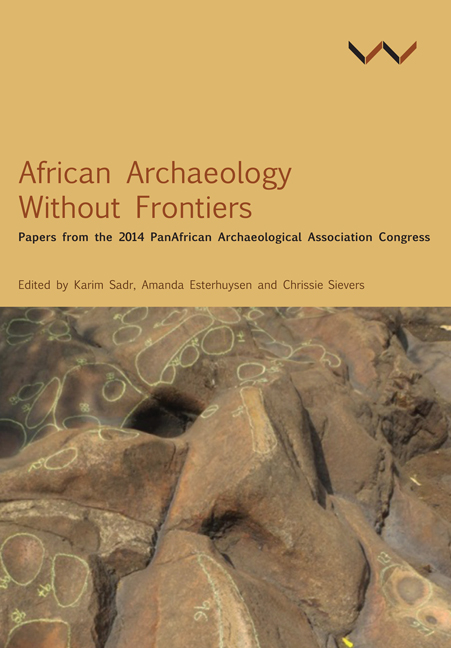 African Archaeology Without Frontiers
African Archaeology Without Frontiers Book contents
- Frontmatter
- Contents
- Acknowledgements
- List of Figures and Tables
- Introduction: An Invitation Fulfilled
- Keynote Address 1: Imagining an African Archaeology Without Frontiers
- Keynote Address 2: A Continental Vision for African Archaeology
- 1 The ‘Useable’ Archaeology of African Farming Systems
- 2 Defining Cultural Heritage among the Makonde of Tanzania
- 3 The Indigenous Roots of Swahili Culture in Pangani Bay, Tanzania
- 4 Is This an Anvil? Iron Bloom Crushing Sites in Northern Togo
- 5 L'art Rupestre au Cameroun, Nouvelles Découvertes et Contribution à L'iconographie Sous-Régionale
- 6 Archaeology and History in Iron Age Settlements in the Congo Basin
- 7 Learning from Glass Trade Beads at Thabadimasego, Botswana
- 8 Blurring Boundaries: Forager–Farmer Interactions in the Middle Limpopo Valley
- 9 Heritage Management and the World Wide Web: South African Challenges
- Contributors
- Index
Keynote Address 2: A Continental Vision for African Archaeology
Published online by Cambridge University Press: 15 March 2018
- Frontmatter
- Contents
- Acknowledgements
- List of Figures and Tables
- Introduction: An Invitation Fulfilled
- Keynote Address 1: Imagining an African Archaeology Without Frontiers
- Keynote Address 2: A Continental Vision for African Archaeology
- 1 The ‘Useable’ Archaeology of African Farming Systems
- 2 Defining Cultural Heritage among the Makonde of Tanzania
- 3 The Indigenous Roots of Swahili Culture in Pangani Bay, Tanzania
- 4 Is This an Anvil? Iron Bloom Crushing Sites in Northern Togo
- 5 L'art Rupestre au Cameroun, Nouvelles Découvertes et Contribution à L'iconographie Sous-Régionale
- 6 Archaeology and History in Iron Age Settlements in the Congo Basin
- 7 Learning from Glass Trade Beads at Thabadimasego, Botswana
- 8 Blurring Boundaries: Forager–Farmer Interactions in the Middle Limpopo Valley
- 9 Heritage Management and the World Wide Web: South African Challenges
- Contributors
- Index
Summary
Akinwumi Ogundiran
Distinguished guests, colleagues, ladies and gentlemen, I respectfully acknowledge all the previously established protocols. I bring you greetings with as-salāmu ‘alaykum in Arabic, sälam in Amharic, hujambo in Swahili, e· kú'kàleè· in Yoruba, ndewo in Igbo and sawubona in Zulu. I am grateful to the local organising committee for giving me the honour and privilege to address this second joint conference of the PanAfrican Association for Prehistory and Related Studies (PAA) and the Society for Africanist Archaeologists (SAfA). I dedicate this talk to the founding fathers and mothers of our two associations, and to the younger generation of African and Africanist archaeologists.
I would like to start my brief remarks by sharing with you a story from the vast repertoire of Yoruba mythology. This is the story of Èṣù and two best friends. These two friends were archaeologists. They were in the field one summer digging at adjacent sites when Èṣù, one of the major deities in the Yoruba pantheon, passed by. He walked on the narrow path that divided the sites of the two friends. That fateful day, Èṣù was wearing a very tall hat, blue on one side and red on the other. He exchanged pleasantries with both men. Later in the day, while the two friends were taking a break, they talked about the man with the gorgeous hat. One of the friends referred to him as the redhat man. The other called him the blue-hat man. Then they stopped to ask each other whether they were talking about the same man. They agreed that indeed it was the same person but they could not agree on the colour of his hat. The two friends argued passionately, each saying he saw and knew the true colour of the hat that Èṣù was wearing. They exchanged unpleasant words as each man professed to know the right answer and demanded to be acknowledged as the victor in the emerging violent discussion. They were on the verge of destroying their long-standing friendship when Èṣù suddenly reappeared. He stopped the quarrel. The friends explained their disagreement.
- Type
- Chapter
- Information
- African Archaeology Without FrontiersPapers from the 2014 PanAfrican Archaeological Association Congress, pp. xxix - xlivPublisher: Wits University PressPrint publication year: 2016
